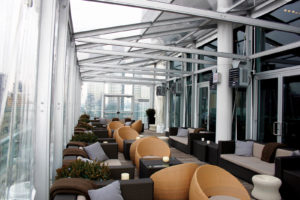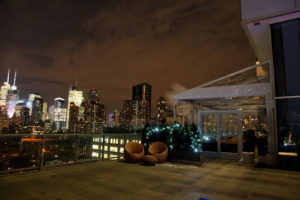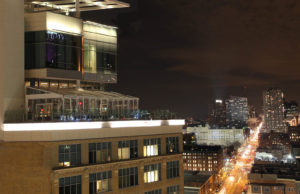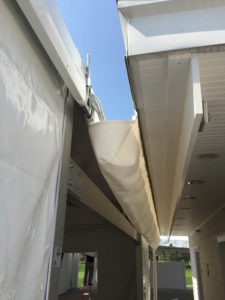
Connecting tents to existing buildings requires customization and time.
By their nature, tents are portable, temporary structures. Buildings are permanent and immobile. From time to time, the two meet and that’s where things get interesting. Connecting a tent to a building for an event marries the permanence and stability of a building with the temporary and novel atmosphere of a tent. When done well, a seamless transition blends the indoors and outdoors together, creating a unique experience. Getting it just right, however, takes a lot of forethought and customized work.
The first step is determining whether a tent can be safely and securely connected to a building. “The first thing we do is get as much information as we can about the potential project,” says Robert Traina, president of Peterson Party Center Inc. of Woburn, Mass. “We have to determine if we can do it. Every site is different and requires special consideration.”
Dan Chase of Chase Canopy Co., Mattapoisett, Mass., makes his determination based on the shape of the building, the height of the eaves and the slope of the roof. “I check to see if there are light fixtures in the way, how tall the doors are, and what material we are being asked to connect to,” he says. “Is it a commercial building or shingles or stucco on a private home? All of these things contribute toward determining whether or not it can be done. Many customers ask if we can just ‘throw a tent in here.’ The answer is no. If you are going to do it, you have to do it right.”
Traina explains that there are more limitations to a tent-to-building project than with a traditional tent setup. “We don’t have the myriad choices for placement, tent type and anchoring that we normally would,” he says. “In many cases, we aren’t able to actually physically connect the tent to a building, either because we can’t gain permission from the building owner or because it just isn’t physically feasible.”

Hardware solutions
When a tent can be physically attached to a building, it is important to select the right hardware for the job. Stephen Frost, president of Stamford Tent & Event Services, Stamford, Conn., takes it on a case-by-case basis. “Every circumstance is different. On some custom jobs we use a head rod and clamps to clamp the wall and fabric to the building, provided we can screw into it,” he says. “It kind of looks like a Keder strip, which is then clamped to the base of the building.”
Chase’s experience has led him to unique solutions, as well. “I have done things like take metal flashing and slip it under a row of shingles on a house under a door,” he says. “I can put some fasteners on that, and the pressure from the shingles is enough to hold it in place for a day or two while the event happens. In other cases, you have to put a screw eye into a building to run a string to hang a gutter on.”

Chase also uses an expedient method for working with repeat customers, such as hotels. “When we have a hotel or inn that asks us to regularly attach tents for events throughout the year, we will actually install Keder tracks on the buildings and have gutters custom made to slide into the tracks,” he says. “The advantages quickly become apparent to the customer, including ease of setup and reduced cost. You paint the track the same color as the trim of the building, and it’s always there. There is some legwork to get the gutter custom made, but it is worth it, in my opinion.”
To create a solid transition from building to tent, Traina explains how building temporary door frames inside existing door frames can help. “If a building has a nice big door, we will build a frame right inside it that we use for attachments,” he says. “We have even built temporary awning structures suspended above doors that we connect tents to.”
Anytime hardware is used to attach a tent to a building, it is important to minimize damage to the structure. “You just have to be careful,” says Frost. “Use the right drill and the right drill bit. If you’re doing cement or stone, use a masonry bit. If you’re drilling into wood, use a wood bit.”

Freestanding is a must
Not just any tent can be safely attached to a building. The anchor weight and tension requirements of pole tents are usually too strenuous for the structure of a building. Freestanding tents are the safer and more practical choice.
“I won’t do it or try to attach a rope and pole tent to a building,” Chase says. “Trying to attach a pole-style tent to a building is problematic. [They] require staking uniformly all around to give the tent shape and structure. You’re removing some of that when you put it next to a building.” He points out that the amount of force required to anchor a tent can be in the thousands of pounds. Placing that kind of pressure on a building often isn’t possible.
In circumstances where a tent can’t be connected directly to a building, a freestanding tent can rely on its own framework to support itself. Frost agrees. “If you’re abutting the building, it has to be a framed tent,” he says, “because the tensions required exceed what the structure of the building can handle.”

Alternative connections
In circumstances where a tent needs to abut a building, but cannot be physically attached to it, creative measures are required.
“In a perfect world,” Chase says, “the back of a building [would be] completely flat for a height high enough to put a walkway marquee type tent with a flat gable end directly against the building. You [wouldn’t] have any obstructions so you can rest the frame right on building. You now have a very small surface area where water can get in.”
Not every tent-to-building job provides perfect conditions. In situations where a tent abuts a building, Frost uses foam bumpers between the tent end and the building. “You can apply pressure to them without damaging the siding,” he says.

Chase has employed weather stripping to “glue” the ends of a tent to a building surface. More often, he uses custom-made entry surrounds that are approximately 1-foot-wide plywood pieces consisting of two uprights and a cross piece. “We use sandbags to hold it to the ground and place it between the tent and the building,” he says “It is an artificial frame that segues between the tent and building and is the same height as the eave of the tent.”
As creative as most tent crews are, not every job is possible. “In many cases, we just can’t attach them,” Traina says. “It’s hard to say no, but sometimes we just can’t do it.”
But for the many instances when it is possible, attaching or abutting tents to permanent structures is a welcome way to extend your event space.
Jake Kulju is a freelance writer based in Minneapolis, Minn.

Keeping it comfortable
A tent-to-building connection is full of hurdles. One of the trickiest is providing adequate heating and cooling for the tent’s interior. Since most HVAC systems are designed to meet the specific requirements of a building, connected tents need to have their own separate systems. Many installers provide customized sidewalls and flooring that have built-in ductwork for HVAC systems.
In addition, a tight seal must be made between the tent and the building to eliminate drafts and energy loss. “Even if you are able to stand the tent against the house, there will still be a gap where air can come in,” explains Dan Chase of Chase Canopy Co., Mattapoisett, Mass. Chase’s solution is to create custom-made entry surrounds. Held to the ground with sandbags or other weights, the surrounds create a slot for the end of the tent to slide into, filling the gap between the building and the tent. “It’s as tight as you can make it without caulking the tent to the building,” he says.
 TEXTILES.ORG
TEXTILES.ORG


